|
|
|||||||
 |
 |
 |
 |
||||
|
|
|
|
|
|
|
||
|
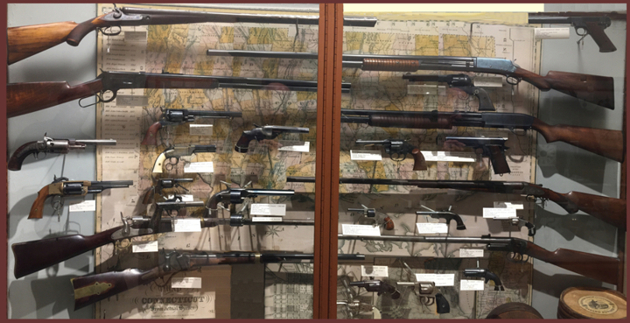
The Connecticut Collections exhibit at the Connecticut State Library in Hartford includes a unique display case of firearms. Each was manufactured in Connecticut
and a sample firearm from over 20 different companies is mounted in the case. As might be expected, firearms from Colt's Patent Fire Arms Manufacturing Company and
other well-known companies are displayed such as those from Allen and Thurber, Manhattan, Whitney, Winchester, and Marlin. I confess, however, to never having heard
of many of the others: Davis Warner, Plant, Crescent, A. H. Howe, Morgan and Clapp, Hood, Joslyn, and Volcanic.
Dick Salzer, writing for the Norwich Historical Society (see reference at end of article), credits Connecticut as especially responsible for New England's
reputation as the center of the American gun industry since the days of the American Revolution. He cites a number of assets responsible for that distinction
including a skilled industrial labor force, good ports and rail lines, and its closeness to the large population centers of New York and Boston.
Talented people added to the above assets in contributing to Connecticut's position in the arms industry. For example, there was Samuel Colt's design, patent,
and production of the multiple-shot revolver. He also brought expert machine designers together in Hartford and pioneered the use of machinery to produce
interchangeable parts, and his use of assembly line production techniques further enhanced the manufacturing process for firearms (and pre-dated Henry Ford's
use of that production tool by a few decades.)
Similar credit can be given to Ethan Allen moving to Norwich in 1842 and joining with Charles Thurber to establish the firm of Allen and Thurber. Although they
stayed in Connecticut only five years, Salzer notes it was Allen and Thurber who pulled together a large number of skilled employees who in turn distinguished
themselves in forming other firearm companies. Among their original employees were Thomas Bacon, a machinist who would eventually form three Connecticut firearm
companies under his own name, and Horace Smith who teamed with Daniel Wesson to perfect the Wesson design for a rimfire cartridge and then went on to establish the
Smith and Wesson company in Norwich to manufacture their own well-known revolvers.
When employees left one company to join another (sometimes a few blocks away) or to start their own, they often brought what they learned along with them.
Sometimes their experiences stimulated new ideas, and sometimes it led to duplication. Salzer points out that certain parts for Allen and Thurber, Bacon, Manhattan,
and early Hopkins and Allen pistols were virtually interchangeable and could be obtained from the same local foundry.
To complete my story about the guns in the display case, I have selected a few to highlight. Starting with the ring trigger guns in the display, the
photos below show closer views of the North and Savage revolver in 36 caliber made between 1856 and 1859. Flayderman (see reference below) refers to this as the
Figure 8 Navy model. To the right is the Volcanic Repeating Arms ring trigger repeating pistol in 32 caliber made between 1855 and 1857 before the company
became the New Haven Arms Company and then Winchester Firearms.
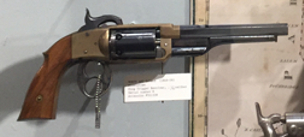 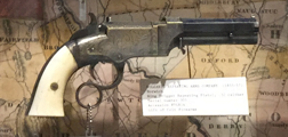
The photo below to the left is the Connecticut Arms and Manufacturing Company firearm model in the display. The information note in the display case indicates
that this is a 44 caliber pocket pistol, but Flayderman refers to it as a rimfire single-shot deringer made for almost 20 years in Naubuc, CT. Next to it is the
Davis Warner double action 32 caliber revolver made in Norwich between 1928 and 1932.
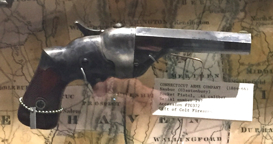 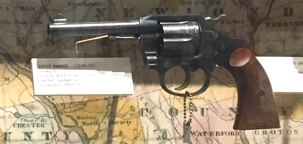
On the left below is a Hood Firearms Company 38 caliber pocket revolver with a spur trigger. Flayderman notes that this model is generally classified as
a "suicide special" and adds that Hood Firearms probably made more of these models than any other company making that type of weapon. Next to it is the "Captain
Jack" 22 caliber pocket revolver made by Hopkins and Allen, another company manufacturing "suicide specials." In describing the company, Flayderman
includes the Hopkins and Allen claim to being "the largest manufacturers of high-grade, popular priced firearms in the world."
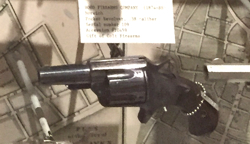 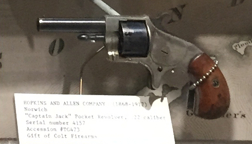
The Plant's Manufacturing Company front loading pocket 38 caliber revolver is on the left below and was made in the mid-1860s. Flayderman estimates over 20,000
were manufactured in the mid-1960s. Next to it is the Bacon Arms Company 22 caliber rimfire pepperbox. Having previously worked for Allen and Thurber in making
their pepperboxes, Bacon was naturally influenced in producing pepperboxes when he started his own company.
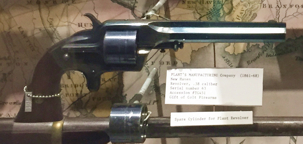 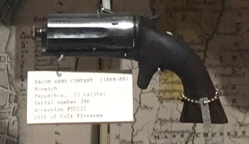
The 50 caliber U.S. Calvary carbine below was produced by A. H. Howe in Hartford. It apparently was manufactured only in 1864, probably under a government
contract.

The Morgan and Clapp 22 caliber pocket pistol pictured below to the left was made in New Haven between 1864 and 1866. The pistol is classified as a single-shot
deringer by Flayderman who also notes it was made in a 30 caliber rimfire model. Finally to the right is the Joslyn Firearms Company 44 caliber, 5-shot Army Model
Revolver made in Stonington. Flayderman notes that these revolvers were made between 1861 and 1862 and that an unusual feature is their solid frame and side-mounted
hammer.
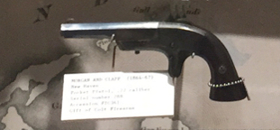 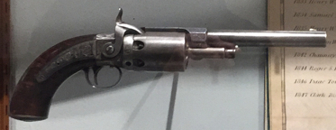
A final footnote to this story concerns the well-known reputation of Colt for being very protective of his firearm patents. He would regularly purchase newly
manufactured guns made by others and would examine them to make sure there was no infringement of any of his patents. If any were found, he would immediately
proceed to take action to protect his patents. Although the display case in the photo at the beginning of this story contains only two Colt-made firearms, 13 of
the other guns were gifts of Colt Firearms to the state library and museum and placed in this display. Of the 11 guns described in more detail above, 9 were gifts
of Colt Firearms – only the North and Savage and Davis Warner models were not a gift of Colt. I hazard to guess that some of these guns donated by Colt Firearms may be quite
difficult to find elsewhere and that without Colt's gifts, the display would be far less impressive than it is.
The exhibit will interest any fan of early American firearms. If in the Hartford area, do plan a visit to the state library to see it...and also check out at the
same time the impressive Colt Firearms Collections at The Connecticut State Library which is only 50 feet away.
Note: An edited version of this story has been published in The Cowboy Chronicle, June 2015, pp.52-55.
References used in story:

|
|||||||
|
|
|||||||
|
|
|||||||
|
|
|||||||